Why Is My Car Insurance So High?
Here are five reasons your car insurance rate might seem high right now and what you can do about it.

Many, or all, of the products featured on this page are from our advertising partners who compensate us when you take certain actions on our website or click to take an action on their website. However, this does not influence our evaluations. Our opinions are our own. Here is a list of our partners and here's how we make money.
Car insurance rates are on the rise. In May, the cost of car insurance was 7% higher compared to a year ago, according to data from the U.S. Bureau of Labor Statistics. And more than half of Americans said they’ve noticed an increase in their own car insurance rate in the past year, according to a recent NerdWallet survey. If you’re like them, you’re probably wondering: “Why is my car insurance so high?”
Unfortunately, there’s no single answer. Many factors influence the price you pay for auto insurance. Some might seem obvious, like having a recent speeding ticket on record. But others may be less apparent, like your marital status or ZIP code.
Here’s how different traffic violations can impact rates. The rates below are for 35-year-old drivers with good credit and full-coverage insurance.
Average car insurance rates
| Driver profile | Full coverage | Minimum coverage |
|---|---|---|
| Clean driving record, good credit | $2,300 | $627 |
| One speeding ticket, good credit | $2,931 | $799 |
| One at-fault crash, good credit | $3,405 | $924 |
| One DUI, good credit | $4,265 | $1,201 |
| Clean driving record, poor credit | $3,850 | $1,004 |
There are five main reasons your car insurance might be expensive:
» Skip ahead: How to save on car insurance
See what you could save on car insurance
Easily compare personalized rates to see how much switching car insurance could save you.
Why your car insurance is so high
These are the five most likely reasons your car insurance rate might be high right now, along with some tips on what you can do to lower your bill. (Some states ban the use of one or more of these factors in insurance pricing, so they may not all apply where you live.)
1. Your personal characteristics
Age
Young, inexperienced drivers are more likely than older drivers to get in a fatal accident. As a result, insurance companies generally charge higher rates for drivers in their 20s, according to NerdWallet’s most recent rate analysis.
Below are the average annual full-coverage and minimum coverage rates for drivers of different ages with a good driving record and good credit.
Average car insurance rates by age
| Age | Full coverage | Minimum coverage |
|---|---|---|
| 20 | $4,684 | $1,323 |
| 30 | $2,375 | $645 |
| 35 | $2,300 | $627 |
| 40 | $2,232 | $611 |
| 50 | $2,074 | $579 |
| 60 | $1,988 | $571 |
| 70 | $2,125 | $641 |
Gender
In most states, insurers can charge different rates for male and female drivers. This often means young men are charged higher rates than young women. The price gap between men and women decreases dramatically by age 30, although it never disappears entirely. A handful of states — including California, Hawaii, Massachusetts, Michigan, Montana, North Carolina and Pennsylvania — don’t allow insurers to differentiate by gender.
Marital status
Most large auto insurance companies have lower rates for married drivers than for those who are single, separated, divorced or widowed.
Education
Drivers with college degrees generally pay less for car insurance. Insurers say highly educated people tend to file fewer claims. However, using education levels in setting prices has come under fire in recent years, and some states are moving away from allowing this practice.
Address
Location is one of the primary factors affecting your car insurance rates. Average premiums vary dramatically by state because each state has different regulations. Rates also vary significantly by ZIP code and neighborhood. For instance, rural drivers pay less than those in cities, where vandalism, theft and crashes are more common.
Occupation
Drivers with certain occupations pay higher rates because they’re more likely than others to file insurance claims, according to some insurers. But consumer advocates have challenged the use of occupation in setting car insurance rates. Some states have banned it or are considering a ban.
Credit history
In many states, insurance companies use credit-based insurance scores, which are different from your regular credit score, to set prices. Your credit score is typically a good indicator of your credit-based insurance score.
On average, a 35-year-old good driver with poor credit pays 67% more for full coverage car insurance than an equivalent driver with good credit, a NerdWallet analysis found. Critics have questioned the validity of using credit history to determine a driver’s car insurance rate.
Home ownership
Some companies give homeowners a price break on car insurance, even if they don’t buy homeowners coverage through the same insurer. Many offer discounts if you bundle multiple policies, such as homeowners and auto insurance, with the same company.
See what you could save on car insurance
Easily compare personalized rates to see how much switching car insurance could save you.
2. How you drive
Driving record
If you’ve had at-fault accidents, traffic tickets or violations like a DUI, you’ll pay more for car insurance than a driver with a clean record. For example, a 35-year-old driver with good credit and a DUI on their record will pay 92% more than a similar driver with a clean record pays for minimum coverage, NerdWallet’s analysis found. In some cases, you might need a company that specializes in insuring high-risk drivers.
Mileage
Low-mileage drivers often get cheaper car insurance, because less time on the road means fewer opportunities for an accident. Low-mileage drivers may also save by choosing pay-per-mile insurance, which tracks how many miles they drive to set premiums.
Car storage
Keeping your car in a garage is less risky than parking it on the street, and your insurance rates may reflect this.
Years of driving experience
If you started driving at 23, you’ll probably pay more for car insurance at 25 than someone your age who’s been driving since 16. Your rates are likely to decline as you get more experience behind the wheel.
3. Your vehicle
Car make and model
Your rates are based in part on the claims your insurer has seen from other people who drive the same model as the car you’re insuring. Sports cars often have high insurance rates, for example, in part because insurers are more likely to pay out large claims from speeding drivers.
Insurance companies also consider factors like how much a vehicle will cost to repair, how popular it is with car thieves and how likely it is to damage another car in an accident. For example, insurance for electric cars tends to cost more due to their higher price tags and specialized parts.
Trim level
Vehicles with extra features like lane sensors, backup cameras and high-end audio can cost more to repair — and therefore more to insure — than base models of the same vehicle. Moving to a higher trim level typically raises not just the price of the car but also the insurance premium.
» MORE: How to buy a new car
Safety features
Vehicles with a strong safety record and good safety equipment often qualify for discounts. On the other hand, some safety features can lead to higher premiums, because high-tech safety equipment can be expensive to repair or replace after an accident.
See what you could save on car insurance
Easily compare personalized rates to see how much switching car insurance could save you.
4. Your car insurance choices
Insurance company
If you’re looking at your declaration page and wondering why your car insurance rate is so high, a big reason might be the insurance company you chose. You could potentially save hundreds if not thousands per year on full coverage by switching from the state’s most expensive insurers to the cheapest, according to our analysis.
And just because a company is cheapest in one state doesn’t mean it’s the cheapest across the country. That’s why it’s important to shop around and compare car insurance quotes to find the best car insurance rates for you.
» MORE: Cheapest car insurance
Don't choose an insurer based on rate information alone. Consider the company's customer service, financial strength and complaint information as well. Read NerdWallet's auto insurance reviews to learn more.
Insurance lapses
Failing to pay your car insurance bill or canceling your policy because you’re between vehicles can cost you. Coverage gaps can make you seem like a higher risk in the eyes of insurance companies, and they’ll often raise your rates in response — or even deny you coverage altogether. To avoid this, consider pausing or reducing your coverage if you can’t afford your current premium.
Coverage selected
It’s no surprise that the more coverage you get, the more it will cost. We found that full coverage auto insurance costs $2,300 on average, compared to $627 for minimum coverage. A full-coverage policy includes collision and comprehensive coverage, which pay to fix or replace your car after a variety of mishaps, like if you collide with other vehicles or animals, or if it’s stolen.
Add-ons like new car replacement coverage can boost the price, but the benefits may be worth it to you. That's why it's important to compare policies with the same coverage limits when you shop around.
Deductible amount
Your deductible is the amount you pay out of pocket when your insurer pays for a claim. For example, if your insurance company approves $3,000 worth of repairs and your deductible is $500, your insurer will pay $2,500. Your insurance premiums will be lower if you choose a higher deductible, like $1,000, but the payout will be lower if you have an accident.
Loyalty
You might expect your car insurance company to reward your years of loyalty with discounts, and some do. But some insurers try to predict which customers are the least likely to switch insurers and squeeze more profit from them through rate increases. Some states have banned this practice, called price optimization. It’s a good idea to compare car insurance rates to make sure your loyalty isn’t costing you.
Discounts
Don’t assume your insurance company automatically applies all the discounts for which you’re eligible. For example, your insurer won’t know your teen is getting good grades unless you provide proof and ask for a good student discount. Insurance companies have tons of discounts, and you may save money by reviewing them with your agent on a regular basis.
5. Economic factors
Rising costs
Rising costs from inflation don’t just impact people — they impact insurance companies, too. And the multi-year spike in car prices and repair costs means many insurers must increase rates to keep up with more expensive payouts.
Increase in claims
On top of having to pay more for an insurance claim, insurance companies are also receiving a greater number of claims. The recent uptick in traffic fatalities and financial losses from extreme weather events have caused many insurers to raise rates to cover costs.
The cost of car insurance keeps going up
The below chart shows the change in car insurance prices over time, based on consumer price index data from the Bureau of Labor Statistics . While prices nosedived in the midst of the COVID-19 pandemic, they quickly rebounded and have been rising sharply since December 2021, with only one slight dip in May 2024.
While insurance companies base rates on a medley of personal and economic factors, this steep rise is largely a reflection of the increase in car insurance claims, bad accidents and vehicle costs insurers have had to contend with in recent years.
How to save on car insurance
If you’re wondering how to get cheap car insurance, here are six things you can try:
Compare quotes from multiple insurers. Use NerdWallet’s car insurance comparison tool to easily shop for cheap auto insurance online. You may find that you already have the best car insurance deal, but prices can change, so check roughly once a year.
Consider dropping coverage that you don’t need. If you finish paying off your car loan, you may be able to lower your rates by getting rid of comprehensive and collision coverage. However, this should only be an option if you could afford to replace your car yourself if it were totaled.
Ask for discounts. You could save money from car insurance discounts you’re not taking advantage of. For example, maybe you work from home and don’t drive much. Mention that and you might get a low-mileage discount. Other common discounts are given for bundling car insurance with homeowners insurance, insuring multiple cars on the same policy and being a student.
Cash in on major life changes. Certain life events could translate to cheaper car insurance, so shop for quotes whenever something major changes in your life. For instance, many companies offer a lower rate for married couples or domestic partners. Or perhaps you moved to a suburb with lower accident and crime rates. Even if you moved to a more expensive area for car insurance, shopping around can help you get cheaper coverage.
Raise your deductible. The higher your car insurance deductible, the more you pay out of pocket before insurance pays for a covered claim. The upside is that by raising your deductible, you’ll usually be able to lower your premium. Just make sure you have enough money set aside to cover the higher deductible if you ever get in an accident.
Revisit quotes after your driving record improves. Shop for cheap auto insurance quotes online three to five years after any accidents, tickets or moving violations. They may have dropped off your driving record.
Reconsider the car you drive. The type of car you drive affects how much you pay for auto insurance. For example, new and expensive cars tend to cost more to insure than older or less expensive cars, among other factors. Check out NerdWallet’s analysis of the cheapest cars to insure to see if your vehicle made the list.
NerdWallet averaged rates based on public filings obtained by pricing analytics company Quadrant Information Services. We examined rates for men and women for all ZIP codes in all of the 50 states and Washington, D.C. Although it’s one of the largest insurers in the country, Liberty Mutual is not included in our rates analysis due to a lack of publicly available information.
In our analysis, “good drivers” had no moving violations on record; a “good driving” discount was included for this profile. Our “good” and “poor” credit rates are based on credit score approximations and do not account for proprietary scoring criteria used by insurance providers.
These are median rates, and your rate will vary based on your personal details, state and insurance provider.
Sample drivers had the following coverage limits:
$100,000 bodily injury liability coverage per person.
$300,000 bodily injury liability coverage per crash.
$50,000 property damage liability coverage per crash.
$100,000 uninsured motorist bodily injury coverage per person.
$300,000 uninsured motorist bodily injury coverage per crash.
Collision coverage with $1,000 deductible.
Comprehensive coverage with $1,000 deductible.
In states where required, minimum additional coverages were added. We used the same assumptions for all other driver profiles, with the following exceptions:
For drivers with minimum coverage, we adjusted the numbers above to reflect only the minimum coverage required by law in the state.
We changed the credit tier from “good” to “poor” as reported to the insurer to see rates for drivers with poor credit. In states where credit isn’t taken into account, we only used rates for “good credit.”
For drivers with one at-fault crash, we added a single at-fault crash costing $10,000 in property damage.
For drivers with a DUI, we added a single drunken-driving violation.
For drivers with a ticket, we added a single speeding violation for driving 16 mph over the speed limit.
We used a 2023 Toyota Camry LE in all cases and assumed 12,000 annual miles driven. We analyzed rates for drivers of the following ages: 20, 30, 35, 40, 50, 60 and 70.
These are rates generated through Quadrant Information Services. Your own rates will be different.










